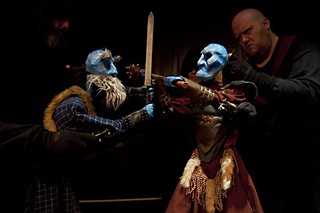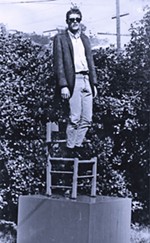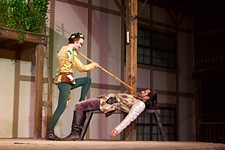Toil and Trouble: A Troubling Turn on Shakespeare's Macbeth
Trouble Puppet makes the magic real in its magical retelling of Shakespeare's Macbeth
Reviewed by Dan Solomon, Fri., Nov. 16, 2012

Toil and Trouble: A Troubling Turn on Shakespeare's Macbeth
Salvage Vanguard Theater, 2803 Manor Rd., 573-2540www.troublepuppet.com
Through Nov. 18
Running time: 1 hr., 55 min.
Toil and Trouble, Trouble Puppet Theater Company's adaptation of Macbeth, seems almost inevitable. The company's bread and butter has been reinterpreting classic texts – from the gritty muckraking of Upton Sinclair to the fantasies of Mary Shelley – and revealing a new depth to the works that can be found only when you see all of the characters as puppets. And Connor Hopkins, the company and production's leader, understands that what makes puppets work is also what makes Macbeth work: manipulation.
From the play's opening scene, in which the glowing, inhuman faces of the Witches fly through the air – an effect that appears eerily authentic when done by puppets – it's clear that the parallel between the way that the human puppeteers control the actions of their articulated subjects and the way that Lady Macbeth, the Witches, and Macbeth himself manipulate those around them is very much on Hopkins' mind. In Toil and Trouble, the cast is costumed so as to be nearly invisible. The members who control the Witches wear fully masked, black bodysuits; others are dressed in dark, hooded robes – save for Zac Crofford, who stars as Macbeth, and Caroline Reck, as Lady Macbeth. Those two keep their faces uncovered, and granting audiences the opportunity to see who controls the characters' actions drives home the point that their actions are being guided by forces beyond their control.
That's something Toil and Trouble makes clear in other ways, as well. In this telling of the story, the supernatural elements aren't allegorical. The Witches fly and float, disincorporate parts of their bodies, and disappear at will; Banquo's ghost is less a symbol of Macbeth's shame than a true glowing apparition; the spookiness of Macbeth becomes genuine magic in Toil and Trouble, inherently believable because of the unreality of the puppets. We've already seen the giant creatures pulling the strings. What's to keep us from believing the Witches' prophecies are fact?
Toil and Trouble succeeds on a number of levels. It's technically gorgeous, with a multileveled set that uses projected backgrounds to suggest the depth of the world its characters inhabit. The spooky atmosphere is maintained by Buzz Moran's sound design and Graham Reynolds' score, aided by a surfeit of dry ice. The articulation of the puppets remains stunning (the fight choreography, as Macbeth wields his mace, is particularly striking), and Hopkins' casting – with savvy twists like using the childlike voice of Gricelda Silva to speak as King Duncan – is both highly effective and surprising. Trouble Puppet is on a hell of a roll, maintaining a level of consistency over the past several years that should be the envy of many Austin companies. On Toil and Trouble, the real magic at work is once again finding a way to enhance the humanity of an oft-told story by replacing the humans with blue-faced puppets.












